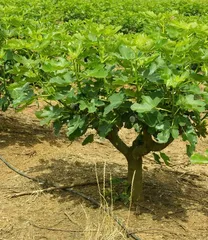The yard is our private space. Planting a fig tree at home can not only make the yard more beautiful but also allow you to enjoy the sweet taste of figs. Can fig trees be planted in the yard? What are its varieties? How to maintain it? Please see the following.

1. What is a fig tree?
Fig trees are a common type of fruit tree, named for their inconspicuous flowers. They are a deciduous tree that grows rapidly, usually as a single plant, and prefers a warm and humid climate.

2. Where are fig trees suitable for planting?
Because fig trees grow rapidly and have lush branches and leaves, they need plenty of sunlight and space to grow, so it is best to plant them in a yard or a spacious garden.
3. What are the varieties of fig trees?

There are many varieties of fig trees, common ones include Black Mission, Kadota, Brown Turkey, and Celeste. Choose a variety suitable for local planting based on geographical location and climate conditions.
4. How to choose a fig tree?
When purchasing a fig tree, you need to pay attention to the variety, age, and quality. The variety should be chosen according to the local climate. The age of the tree should be 3-5 years. A high-quality fig tree has many leaves and healthy branches.
5. How to plant a fig tree?
Planting a fig tree requires digging a hole about 60 cm deep and 80 cm wide in a sunny location. Place the fig tree in the hole and backfill with loose soil and plenty of water.
6. How to care for a fig tree?
Fig trees have high requirements for the care environment, including keeping the soil moist, preventing sunburn, pruning branches and leaves in a timely manner, and regular fertilization.
7. How to fertilize?
Spring and autumn are the best times for fertilization. You can use organic fertilizer or chemical fertilizer. Fertilize twice a year, but be careful not to over-fertilize.
8. How to prune?
Fig trees need regular pruning of branches and leaves, especially appropriate pruning in winter to retain healthy branches and leaves and promote growth.
9. How to prevent and control pests and diseases?
Fig trees are susceptible to fungal infections and pests such as aphids and mites. You can regularly spray insecticides and fungicides, and pay attention to maintaining environmental hygiene.
10. How to harvest?
The fruit of the fig tree usually ripens in summer. The fruit is elongated and orange-yellow. It can be picked and eaten when it becomes soft.
11. The effects and functions of fig trees
Figs are rich in nutrients such as vitamin C, calcium, and phosphorus. They have effects like aiding digestion, moistening the lungs and relieving coughs, and clearing heat and detoxifying. They are also beneficial for cardiovascular and respiratory diseases.
12. The economic value of fig trees
Fig trees can not only be used for ornamental purposes but also planted as a commercial crop to harvest a large number of figs, having a certain economic value.
13. The cultural significance of fig trees
Fig trees hold a unique position in ancient Chinese culture and are often used as important items in ceremonies such as worship and celebrations, possessing rich cultural significance.
14. How to protect the ecological environment of fig trees?
When planting fig trees, it is important to protect the ecological environment, avoid behaviors such as excessive deforestation and environmental pollution, maintain ecological balance, and ensure the sustainability of the ecological environment.
15. Conclusion
A fig tree is a fast-growing, lush, and delicious fruit tree. Planting a fig tree in a yard or garden can beautify the environment and increase the harvest, but attention must be paid to selecting varieties, maintenance, and pest and disease control. On the premise of protecting the ecological environment, planting fig trees can not only satisfy people's pursuit of a better life but also exert economic value and cultural significance.